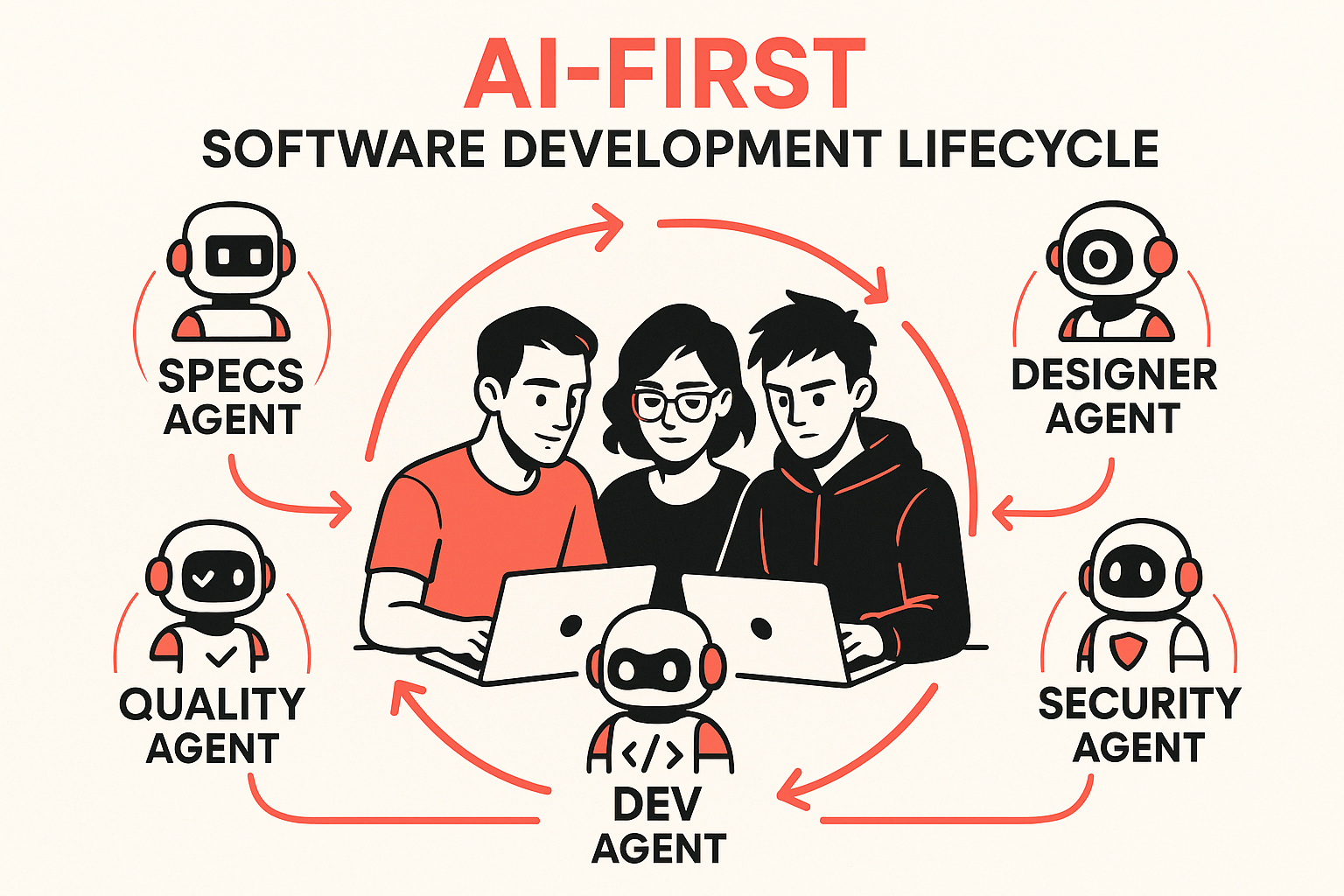AI-first Development Lifecycle
Published 2025-11-11 by Mattia • 5 min read
A practical proposal to rethink software development workflows in an AI-first perspective: orchestrated autonomous, specialized agents that delegate work to AI while keeping humans as supervisors and fallback.

We are retrofitting AI onto the classic SDLC
For those of us who experiment with and use AI in software development, integrating these tools into various stages of the SDLC (Software Development Life Cycle) has become common practice. Right now, however, the prevailing trend is often to retrofit AI onto existing processes rather than redesign them with an AI-first mindset. This approach is sensible and timely, but it should not be the end goal.
To go further, I believe it’s time to question the traditional software development workflow and invert the approach: make AI the default engine, and use people as supervisors, reviewers, and fallback for tasks that AI cannot perform correctly. This approach will not be effective for every project or team today, but experimenting in this direction gives us the chance to be ready for what is coming.
The essential ingredient in this vision is, in my view, a set of orchestrated, autonomous and specialized agents.
Autonomous agents
It is becoming clear that the next step, or perhaps the current state of the art, in AI-driven software development is the use of autonomous agents. Major market players are releasing their own solutions, varying in maturity, but sharing some common traits:
- Agents purpose-built for product development that can be configured and specialized.
- Execution in controlled and secure remote environments.
- Support for triggers, hooks and events to build automations.
Some notable products (in no particular order):
Most likely, we’ll have a set of agents, many of which will be third-party products, while some may be built in-house and tailored to our specific needs. We shouldn’t expect end-to-end agents capable of solving complex problems in enterprise contexts (like Lovable, Replit, etc.), but rather specialized and orchestrated agents.
Specialized agents
These agents can be developed to specialize in particular tasks, which makes them more efficient and effective. Specialization typically includes:
- Providing all and only the context required to solve the task.
- Access to all and only the necessary tools (MCP servers).
- Specific rules and guidelines.
Different teams will have slightly different needs, but a common foundation is likely to exist. Therefore, it is reasonable to imagine central teams such as security, quality, or architecture building and maintaining these agents with shared guidelines and best practices, while allowing each product team to extend and customize them within predefined limits.
The idea is for each team to evolve these agents iteration by iteration to better suit their needs, increasing efficiency and effectiveness over time. Modularity and reusability mechanisms will be crucial. See for example Claude Agent Skills.
AI-first Development Lifecycle
I believe the new software development workflow should be AI-first. This does not mean AI-only; it means flipping the traditional workflow so that AI handles as much as possible while people focus on what AI still cannot do well. Initially, teams might still handle around 90% of tasks, but systems should be designed so that, as agent accuracy improves, this percentage can dramatically decrease. This allows us to capture future opportunities and stay ahead of the curve.
I imagine an automation flow where, upon creating a task in the task management system (Jira, Linear, etc.), a first agent assesses whether the provided details are sufficient and, if not, notifies the user, iterating until the requirement is clear.
Then a second agent is triggered automatically to analyze the task and decide whether it can be executed fully autonomously by AI. If not, it assigns the task to a team member. This may sound like premature optimization, but identifying as early as possible when a task requires an engineer’s supervision is critical for efficiency and developer experience.
In general, I envision the team designing a sequence of steps that lead from requirement to result, where for each step there is:
- an automatic AI-powered check determining whether the step can be executed autonomously by AI; if not, an immediate fallback to the team;
- execution of the step by the specific agent;
- an automated downstream check to decide whether the result needs review (not every step must be reviewed, but at least one review should occur before completion);
- a review of the result by the team, when necessary, with any modifications and iterations performed by engineers, designers, product owners or other experts.
The team’s experience
In this model, some tasks could go from being logged in the ticketing system to completion entirely autonomously, requiring only a final review by the team. At the same time, other tasks will remain fully assigned to the team and completed in a more traditional but AI-assisted way. Many tasks will fall in between, partially delegated to AI and partially to humans, with step-by-step evaluation.
An important aspect is the team’s contribution to agent specialization. These agents will become a key asset both for individual teams and for the organization as a whole. The ability of these agents (and therefore of the teams managing them) to implement the product vision with alignment, efficiency, and quality becomes a strategic value.
This will also impact project planning and management, because it will become harder to estimate task completion times when portions or the entirety of the work can be executed autonomously by AI. It will therefore be necessary to revisit Agile frameworks such as SCRUM and move progressively toward continuous delivery practices.